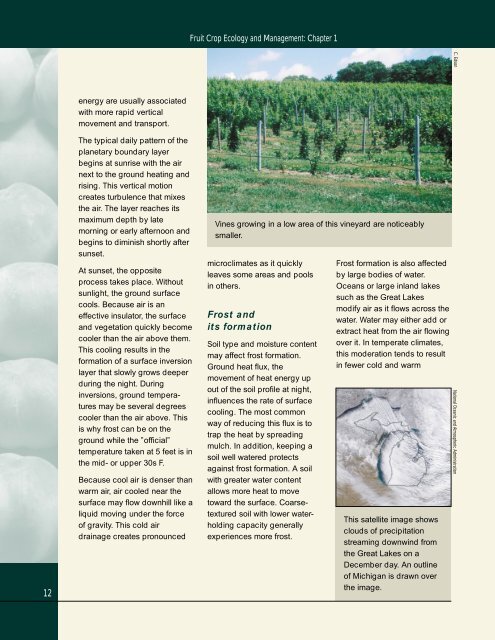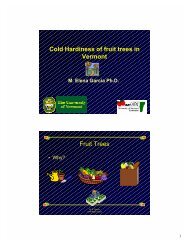Fruit Crop Ecology and Management - UVM Apple Orchard
Fruit Crop Ecology and Management - UVM Apple Orchard
Fruit Crop Ecology and Management - UVM Apple Orchard
You also want an ePaper? Increase the reach of your titles
YUMPU automatically turns print PDFs into web optimized ePapers that Google loves.
12<br />
energy are usually associated<br />
with more rapid vertical<br />
movement <strong>and</strong> transport.<br />
The typical daily pattern of the<br />
planetary boundary layer<br />
begins at sunrise with the air<br />
next to the ground heating <strong>and</strong><br />
rising. This vertical motion<br />
creates turbulence that mixes<br />
the air. The layer reaches its<br />
maximum depth by late<br />
morning or early afternoon <strong>and</strong><br />
begins to diminish shortly after<br />
sunset.<br />
At sunset, the opposite<br />
process takes place. Without<br />
sunlight, the ground surface<br />
cools. Because air is an<br />
effective insulator, the surface<br />
<strong>and</strong> vegetation quickly become<br />
cooler than the air above them.<br />
This cooling results in the<br />
formation of a surface inversion<br />
layer that slowly grows deeper<br />
during the night. During<br />
inversions, ground temperatures<br />
may be several degrees<br />
cooler than the air above. This<br />
is why frost can be on the<br />
ground while the ”official”<br />
temperature taken at 5 feet is in<br />
the mid- or upper 30s F.<br />
Because cool air is denser than<br />
warm air, air cooled near the<br />
surface may flow downhill like a<br />
liquid moving under the force<br />
of gravity. This cold air<br />
drainage creates pronounced<br />
<strong>Fruit</strong> <strong>Crop</strong> <strong>Ecology</strong> <strong>and</strong> <strong>Management</strong>: Chapter 1<br />
Vines growing in a low area of this vineyard are noticeably<br />
smaller.<br />
microclimates as it quickly<br />
leaves some areas <strong>and</strong> pools<br />
in others.<br />
Frost <strong>and</strong><br />
its formation<br />
Soil type <strong>and</strong> moisture content<br />
may affect frost formation.<br />
Ground heat flux, the<br />
movement of heat energy up<br />
out of the soil profile at night,<br />
influences the rate of surface<br />
cooling. The most common<br />
way of reducing this flux is to<br />
trap the heat by spreading<br />
mulch. In addition, keeping a<br />
soil well watered protects<br />
against frost formation. A soil<br />
with greater water content<br />
allows more heat to move<br />
toward the surface. Coarsetextured<br />
soil with lower waterholding<br />
capacity generally<br />
experiences more frost.<br />
Frost formation is also affected<br />
by large bodies of water.<br />
Oceans or large inl<strong>and</strong> lakes<br />
such as the Great Lakes<br />
modify air as it flows across the<br />
water. Water may either add or<br />
extract heat from the air flowing<br />
over it. In temperate climates,<br />
this moderation tends to result<br />
in fewer cold <strong>and</strong> warm<br />
This satellite image shows<br />
clouds of precipitation<br />
streaming downwind from<br />
the Great Lakes on a<br />
December day. An outline<br />
of Michigan is drawn over<br />
the image.<br />
C. Edson National Oceanic <strong>and</strong> Atmospheric Administration



